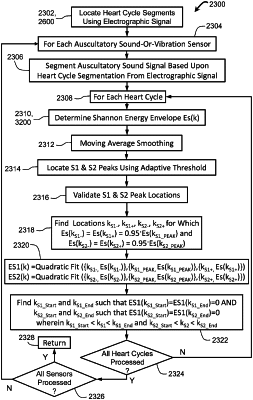| CPC A61B 5/352 (2021.01) [A61B 5/316 (2021.01)] | 28 Claims |

|
1. A method of segmenting an auscultatory sound signal, comprising:
a. receiving an electrographic signal from an ECG sensor;
b. generating an electrographic envelope signal representing an envelope responsive to an even power of said electrographic signal;
c. locating a plurality of peaks of said electrographic envelope signal corresponding to a corresponding plurality of R-peaks of said electrographic signal;
d. receiving at least one auscultatory sound signal from a corresponding at least one auscultatory sound-or-vibration sensor;
e. filtering said at least one auscultatory sound signal with a high-pass filter so as to generate a corresponding at least one high-pass-filtered auscultatory sound signal;
f. segmenting said corresponding at least one high-pass-filtered auscultatory sound signal into at least one heart-cycle segment responsive to said plurality of peaks of said electrographic envelope signal;
g. for each one said at least one heart-cycle segment:
i. generating an auscultatory envelope signal representing an envelope responsive to an even power of said auscultatory sound signal within said one said at least one heart-cycle segment;
ii. locating at least a second peak of said auscultatory envelope signal corresponding to a second heart sound;
iii. generating a local mathematical model of at least said second peak of said auscultatory envelope signal, wherein said local mathematical model comprises a quadratic equation; and
iv. locating at least one root selected from the group consisting of a first root of said local mathematical model and a second root of said local mathematical model, so as to provide for determining an associated start of diastole of said one said at least one heart-cycle segment.
|